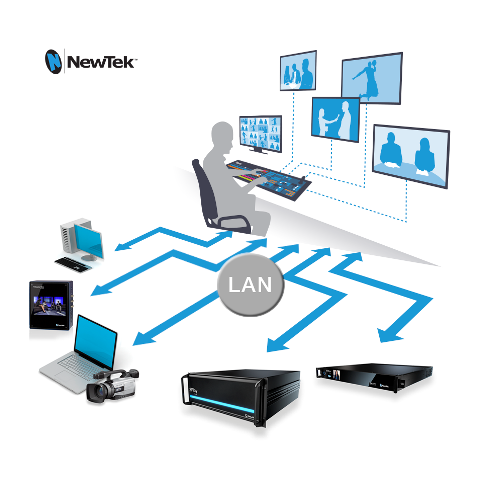The Changing Face of Video Over IP
NEW YORK—The technology to stream video over Internet Protocol has been around for more than 20 years, but it has really only been in the past decade that great strides have been made in its use in video production.
Video-over-IP also comes in many form factors.
Consumers know it mainly as a method for pushing video signals over the Internet directly to the consumer as an alternative to cable or broadcast as an over-the-top streaming service, but it is also a way to transfer file-based media on network-based computers. However, in the world of production, video-over-IP is a method for pushing signals over Ethernet, and is widely being seen as a replacement for SDI.
Video over IP offers numerous advantages, because video can be processed on a computer, while on the production side there are now countless software-enabled solutions. There are multiple options for utilizing video over IP, and one that is increasingly used among content producers and vendors is SMPTE 2022-6, which was ratified in 2012.
SMPTE 2022 AND INTEROPERABILITY
In the latter configuration the SMPTE 2022-6 standard is getting widespread support, and several vendors have announced new products and showed off the interoperability that it offers to broadcasters. SMPTE 2022 was first introduced in 2007 and has expanded to cover more types of IP video transport—positioning video-over-IP as a replacement for SDI.

Wes Simpson “SMPTE 2022-6 offers a number of advantages as it was designed for long-haul contribution style networks,” said Wes Simpson, an industry consultant and author of TV Technology’s Video Networking column. “It was specifically designed to handle up to 1080p video, where you don’t need the bells and whistles.”
What makes SMPTE 2022-6 so attractive, however, is that it offers the ability to use a single standard for high-bitrate, uncompressed signals.
“It is basically the only game in town as it allows the customer to buy equipment from two different manufacturers and send uncompressed signals between them,” Simpson said. “There are no other standards that can offer that today.”
The ability to utilize this interoperability was demonstrated at the 2015 IBC Show, where EVS and Imagine Communications showcased how the 2022-6 standard could handle a video-over-IP stream between the two companies’ respective products. Imagine further demonstrated how the stream could be delivered through routers from four different hardware vendors including Cisco, Arista, Brocade and HP.
“It was exciting to see the interoperability across four switch vendors,” said Brick Eksten, vice president of strategy at Imagine Communications. “This was very much a vendor-to-vendor proof point as it can back haul video and allow for interaction with different equipment.”
Eksten told TV Technology that the company has fully embraced the standard, and has worked closely with its industry partners to ensure that there is a “choreograph between equipment from the different manufacturers.”
LIVE FROM IBC
Video-over-IP could be a real game changer for live production, something EVS was quick to point out at IBC.
“For us, the next frontier is using IP as the infrastructure to execute live production,” said James Stellpflug, vice president of product marketing for the French-based provider of live video production gear. “We’ve been using IP for a long time in the industry in various different levels, whether it be for contribution or inside our broadcast centers for moving files around.”
Video-over-IP will likely replace SDI, and that would also mean a savings in weight, a factor that isn’t often addressed but remains an issue for production teams in the field.
“IP is gaining traction because cabling is expensive and cables are heavy,” said Aaron Behman, who oversees the video and visions strategy at Xilinx, a San Jose, Calif. Provider of semiconductors. “The DOT [Department of Transportation] has restrictions on how heavy vehicles can be. At the same time, video-over-IP offers more and more channels of video with multiple cameras at locations.”
Given that fans of live events—notably sports events such as NASCAR races—want to see as much of the action as possible, this provides that added support.
“There is no doubt that people want to see it all, and you want to be able to provide more immersive video, but also not be concerned that you’re running into weight restrictions,” Behman said. “2022-6 is a building block and it allows video to be sent over Ethernet.”

The TICO Alliance is a group of broadcast equipment manufacturers and media companies that advocates the creation of a lightweight compression technology that will be used in IP-based live production ecosystems to allow users to seamlessly leverage the existing SDI-based workflows to 4K/UHD.WHAT ABOUT UHD?
The main downside to SMPTE 2022-6 is that it isn’t exactly future proof. While it could be seen as a building block that allows video to be sent over Ethernet, the standard is considered to be a transition and can’t handle 4K/UHD raw uncompressed video easily—as SMPTE 2022-6’s pipe supports 10 GB while UHD is about 12 GB.
Compression solutions are already in the works however, and one option touted by some in the industry is TICO, a patent-pending, visually lossless, light-weight compression that specifically has been designed for the industry to move 4K content over active 3G-SDI and IP networks.
“TICO, which essentially means ‘tiny codec’ is gaining traction with big names in the industry,” Behman said. “The industry sees this as a way for 2022 to support 4K/UHD, as it is used to give the video a ‘little haircut,’ and compress it enough to get it down the pipe.”
TICO is just one of several codecs, but these are still essentially stop-gap measures as the industry determines how to best handle UHD video-over-IP.
“TICO is still in its early stages,” said David Ross, CEO of Ross Video, whose company is a member of the TICO Alliance. “You also have to pay a TICO royalty, so it isn’t a perfect solution.”

David Ross Given that the industry is moving to UHD, Ross questioned why IP is being so widely embraced—especially with 2022-6 as the standard.
“2022-6 is industry’s first attempt, but I think it is D2 all over again,” Ross added, referring to the short-lived Ampex videocassette format introduced in the late ’80s. “It is a standard, but it isn’t where the industry will end up. If all we want to do is replace an SDI cable [with Ethernet cable] that is one thing, but this isn't going to be a long-lasting standard.”
ALTERNATIVES TO SMPTE
For those reasons noted above, SMPTE 2022-6 is far from the only game in town. Other vendors have introduced their own respective solutions. At IBC, NewTek introduced its own royalty-free network device interface—NDI open protocol for IP production—with an SDK that will hit the market in Q4.
“Our new NDI protocol SDK will be available to any developer that wants to use it starting in Q4,” said Scott Carroll, spokesperson for the San Antonio-based provider of live production systems. “It will allow any NDI-enabled device to be recognized and share resources with other NDI-enabled resources connected to a LAN on standard Ethernet, allowing producers to maintain their investments in SDI cameras and current network infrastructure. NDI will be included in an update to TriCaster Advanced Edition in Q4 that will add four more inputs to any current TriCaster model.”

Newtek NDI is an IP-based protocol that will allow any NDI-enabled device to be recognized and share resources with other NDI-enabled resources connected to a LAN on standard Ethernet.
NDI is bidirectional, allowing devices to communicate with one another, but more importantly it makes it easy for a production facility to move into video-over-IP without having to make a large capital investment in a high bandwidth network or having to replace SDI devices, according to the company.
Evertz introduced its ASPEN platform for encapsulating uncompressed video-over-IP at the NAB Show, and at IBC, the Burlington, Ont.-based provider of video distribution technology announced a partnership with Ross to add 10GE IP interfaces with ASPEN support for Ross Video’s flagship Acuity series of production switchers. This collaborative effort will allow the use of another alternative to SMPTE 2022-6 in IP-based broadcast production facilities. The Acuity production switchers can be directly connected to Evertz’ Software Defined Video Networking (SDVN) high-capacity switching cores, and allow broadcasters to combine traditional SDI infrastructure with IT-centric hardware and software.
“This can be deployed in a facility and provide individual flows for audio, video and data, all over a single wire,” said Mo Goyal, product marketing manager at Evertz.
Although Goyal admits that “2022-6 is a good method for transporting video-over-IP,” the downside is that it requires auxiliary equipment if you need to re-embed audio into the mix. This is where he noted that ASPEN could help users on the production side break away from the rigid structure of SDI.
With ASPEN, “audio can come from one site and video from another and that offers greater flexibility in the production environment,” Goyal said. “It also reduces the need for all that extra gear, so our package switch is independent. We see ASPEN as the format that completes the puzzle.”
Get the TV Tech Newsletter
The professional video industry's #1 source for news, trends and product and tech information. Sign up below.
